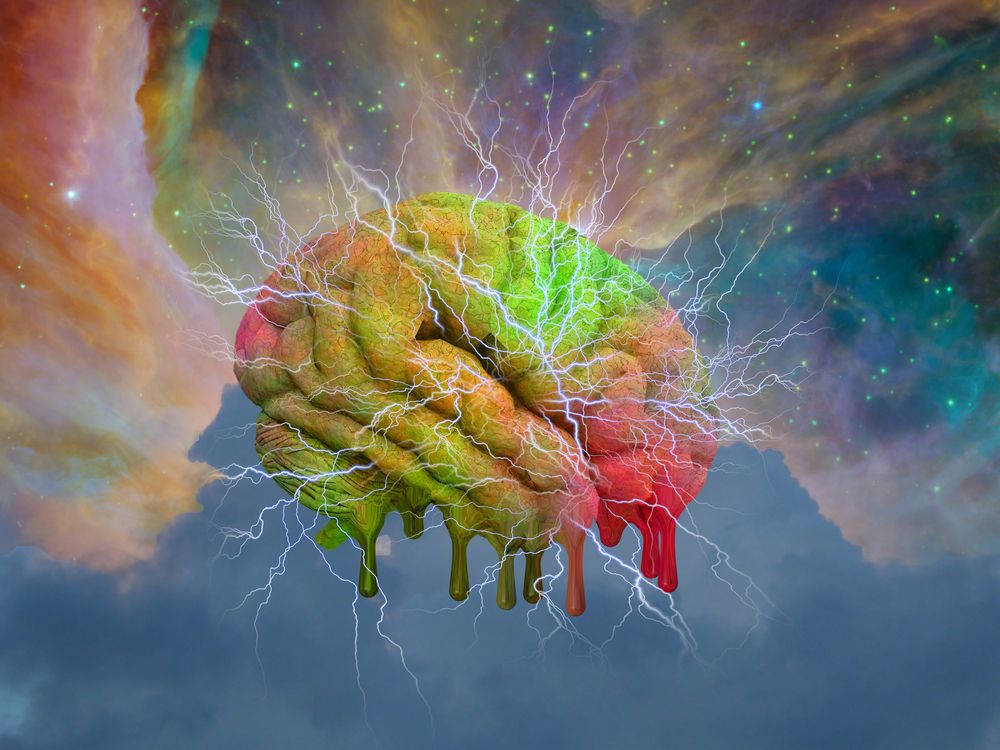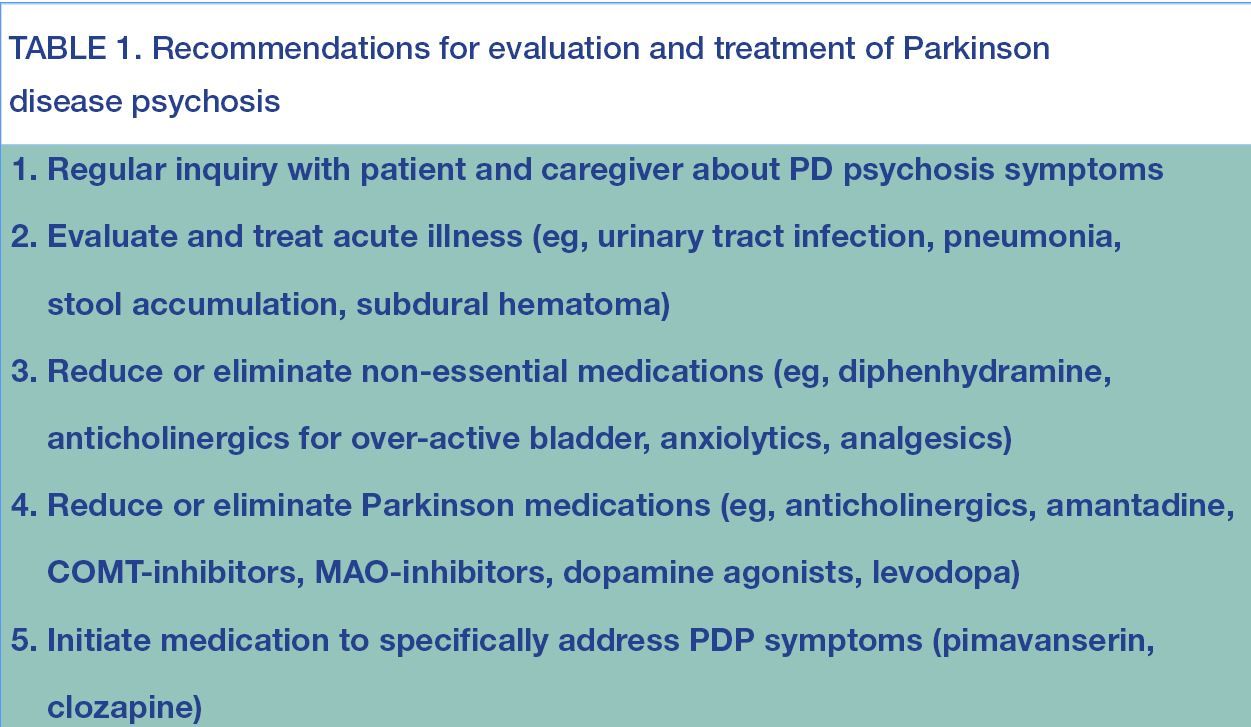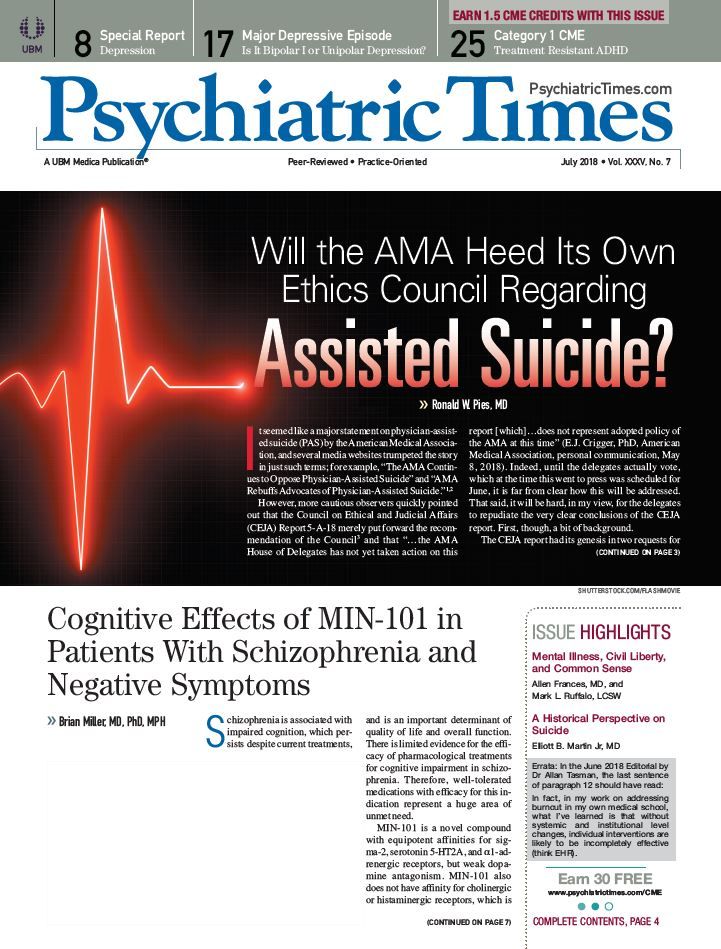Publication
Article
Psychiatric Times
Parkinson Disease Psychosis: Evaluation and Treatment
Author(s):
Psychosis symptoms in patients with Parkinson disease can turn a difficult situation into an untenable one: they are the leading reason that patients leave their homes for continued care in a skilled nursing facility.
©BruceRolff/Shutterstock

Table. Recommendations for evaluation and treatment of Parkinson disease psychosis

The symptoms experienced by people with Parkinson disease (PD) are extensive, and it can be daunting even for an experienced clinician to sort through the diverse symptoms that patients present with. In addition to problems with mobility patients often experience fatigue, weight loss, sleep disorders, bladder and bowel dysfunction, mood disturbance, cognitive decline, and psychosis.
During these visits, providers must prioritize and be especially attentive to those symptoms that have the potential to be particularly disruptive to the patients and their caregivers. Although the list of problems associated with PD is long, only a small number may be especially and acutely derailing. Although this includes falls and associated injuries, infections, stool impaction and bowel obstruction, in this article, I focus on psychosis.
Hallucinations and delusions
Psychosis symptoms in PD consist of hallucinations and delusions. The hallucinations are most commonly visual but may involve any of the senses. When hallucinations are initially present, they typically manifest as a sense that someone is standing beside or behind them, or that someone or something has passed through the periphery of their vision. Patients may also have visual illusions, seeing an object differently than what it truly is. A roadside fire hydrant might appear to be a child, or a potted plant appears to be an animal.
Although initially infrequent and nonthreatening, over time the hallucinations generally occur more often, are more complex, involve other senses and become distressing. Patients with PD psychosis symptoms may buy food and set their table for hallucinated guests; refuse to enter their bedrooms or their bathrooms because of their perception that strangers are lurking there; flee their homes to escape, call the police, or arm themselves because the hallucinated intruders are perceived as intending to harm them.
PD psychosis delusions often have content that is paranoid or consists of spousal infidelity. Theft of money or possessions, poisoning by food or medications, including by spouses, family members, or caregivers, are recurrent themes of delusions. Spousal infidelity with hired caregivers, friends and neighbors is a common delusion.
The psychosis symptoms can turn a difficult situation of coping with PD into an untenable one. They worsen quality of life for patients and caregivers, they are a common reason that PD patients present to emergency departments and are admitted to a hospital, and they are the leading reason that PD patients leave their homes for continued care in a skilled nursing facility.
Prevalence and causes
Psychosis symptoms are common in patients with PD. Reported prevalence of psychosis is variable and time dependent-it increases with the duration of illness. One relatively small prospective multicenter study reported that 74% of PD patients experienced visual hallucinations at the 20-year follow up.1
Although psychosis symptoms were previously regarded as adverse effects of dopaminergic medication, it has become clear that this is not entirely correct. Medications do play a role, but neither the medication type nor dosage are clearly correlated with psychosis. Moreover, psychosis symptoms have been reported in patients who have not received any medications for PD.2
The brain substrate enabling hallucinations appears to include parkinsonism with Lewy body pathology, and an increased density of serotonin receptors in the temporal cortex. Risk factors identified for PDP include REM sleep behavior disorder, dementia, depression, patient age as well as duration and severity of PD.
Interestingly, patients and caregivers do not necessarily report these symptoms during their appointments with their treating provider. There are several possible explanations for this: lack of recognition that hallucinations and delusions are part of PD, embarrassment about mental health issues, or that there are too many PD symptoms to discuss in a visit with time constraints.
Treatment strategies
Nonpharmacological treatments for PD psychosis such as reassurance and discussion with the patient are being explored but have not yet been firmly established. Some basic points are worth considering. One of the most important things is making sure that the patient does not have access to guns or other weapons. In addition, it is important to keep in mind that abother acute or subacute illness may cause these symptoms to emerge or increase-symptoms may be due to a simple problem such as a urinary tract infection or something more complex such as a subdural hematoma. Since hallucinations tend to occur in the evening and nighttime with lower light, well lighted rooms and a nightlight may provide some benefit.
Another important factor to consider is how medications are contributing to PD psychosis. Anticholinergic medications (eg, diphenhydramine, oxybutynin) that enter the CNS should be avoided. When possible, reduce or eliminate Parkinson medications, all of which may have a provocative effect on psychosis. Opinions vary on the which medications to reduce or discard, but most experts agree anticholinergics such as trihexyphenidyl and benztropine mesylate should be the first to go.
There is less agreement about the sequence for reduction/elimination of other medications such as amantadine, dopamine agonists, and MAO and COMT inhibitors. Levodopa is generally regarded as the centerpiece for treatment of motor symptoms of PD, and therefore is usually the last medication to be reduced, but seldom, if ever, removed. The method of addressing psychosis symptoms by PD medication adjustment has not been examined in a large clinical study and therefore the success rate, complications, and time course have not been reliably established.
Pharmacological choices to actively treat PDP symptoms have historically included quetiapine and, less commonly, clozapine. Although quetiapine has been commonly prescribed for PD psychosis, studies have been small and short in duration with mixed results regarding efficacy.3 Clozapine, on the other hand, has demonstrated efficacy for psychosis in two clinical trials, although, again, relatively small and of short duration.4,5
Although clozapine was found to be efficacious for PD psychosis, there is insufficient evidence to support efficacy of quetiapine.6 Clozapine is infrequently prescribed, presumably because of the burdensome requirement for monitoring blood counts for the small but potentially fatal risk of neutropenia. Many people, including experienced clinicians, feel that quetiapine has been beneficial for PD psychosis. The discrepancy between formal studies and anecdotal observations is difficult to explain.
Pimavanserin was developed specifically to treat PD psychosis by its action at serotonin receptors, a quality shared by quetiapine and clozapine.7 Pimavanserin was also developed to avoid interactions with other neurotransmitters, particularly dopamine. Pimavanserin has a relatively long half-life of 57 hours, compared with about 6 hours and 14 hours for quetiapine and clozapine, respectively. This means clinical response to pimavanserin may require several weeks to fully assess its efficacy. On the other hand, the long half-life allows for once daily dosing, which is attractive for patients who may be taking several other medications numerous times daily.
In the single, 6-week study that led to FDA approval of pimavanserin for PD psychosis, mean improvement of psychosis symptoms of 37% was seen with the active treatment compared with 14% for placebo.8 Adverse effects included confusion, peripheral edema, and increased hallucinations. As with quetiapine and clozapine, and, for that matter, all antipsychotic medications, pimavanserin has a black box warning about increased risk of death in elderly patients with dementia-related psychosis. However, unlike other antipsychotics, the warning further states that pimavanserin is approved only for hallucinations and delusions associated with PD psychosis.9 The FDA label also carries a warning regarding QT interval prolongation.
At the time of this writing, the lay press was reporting that a number of patients with PD psychosis had died after being treated with pimavanserin. It has not been established that pimavanserin played a causative role in these deaths-no additional cautions have been issued by the FDA regarding associated risks. PD psychosis itself is an independent risk factor for PD mortality.10
Conclusion
Routine querying of patients and caregivers about PDP symptoms is essential for optimal care of patients with PD. Identification of PD psychosis symptoms and earlier treatment may prevent escalation to crises situations and attendant evaluations in emergency departments and hospitalizations, and conceivably allow care to continue at home.
This article was originally published on May 29, 2018, in our partner publication, Neurology Times and has since been updated.
Disclosures:
Dr Hermanowicz reports that he is on the Speakers Bureau and a Consultant for Acadia.
References:
1. Hely MA, Reid WG, Adena MA, et al. The Sydney multicenter study of Parkinson disease: the inevitability of dementia at 20 years. Mov Disord. 2008 30;23:837-844.
2. Pagonabarraga J, Martinez-Horta S, Fernández de Bobadilla R, et al. Minor hallucinations occur in drug-naive Parkinson's disease patients, even from the premotor phase. Mov Disord. 2016;31:45-52.
3. Wilby KJ, Johnson EG, Johnson HE, Ensom MHH. Evidence-based review of pharmacotherapy used for Parkinson disease psychosis. Ann Pharmacother. 2017;51:682-695.
4. Parkinson Study Group. Low-dose clozapine for the treatment of drug-induced psychosis in Parkinson disease. N Engl J Med. 1999;340:757-763.
5. The French Clozapine Parkinson Study Group. Clozapine in drug-induced psychosis in Parkinson disease. Lancet. 1999;353:2041-2042.
6. Seppi K, Weintraub D, Coelho M, et al. The Movement Disorder Society Evidence-Based Medicine Review Update: Treatments for the non-motor symptoms of Parkinson disease. Mov Disord. 2011;26(Suppl 3):S42-80.
7. Hacksell U, Burstein ES, McFarland K, et al. On the discovery and development of pimavanserin: a novel drug candidate for Parkinson's psychosis. Neurochem Res. 2014;39:2008-2017.
8. Cummings J, Isaacson S, Mills R, et al. Pimavanserin for patients with Parkinson's disease psychosis: a randomised, placebo-controlled phase 3 trial. Lancet. 2014;383:533-540.
9. Food and Drug Administration Label. Pimavanserin. https://www.accessdata.fda.gov/drugsatfda_docs/label/2016/207318lbl.pdf. Accessed May 24, 2018.
10. Forsaa EB, Larsen JP, Wentzel-Larsen T, Alves G. What predicts mortality in Parkinson disease? A prospective population-based long-term study. Neurol. 2010;75:1270-1276.






